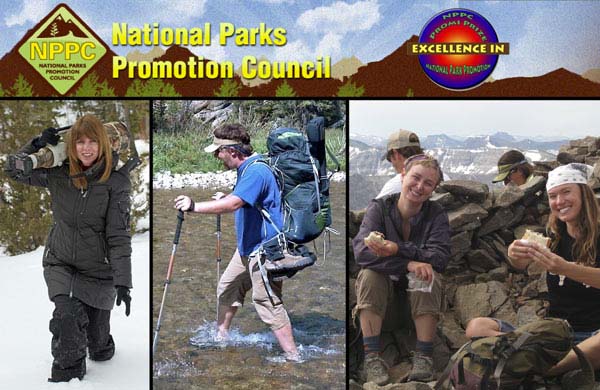
By Ruffin Prevost
CODY, WYO. — A national parks and travel industry insider has hailed the work of Yellowstone Gate readers in sharing information about Yellowstone and Grand Teton national parks, but cautions that visitation is declining at most parks over the long term.
“As a whole, national parks are losing visitation, and that’s been going on for about 20 years,” said John Poimiroo, CEO of the National Parks Promotion Council.
 Poimiroo last week awarded Yellowstone Gate — or more properly, the site’s readers who have contributed their stories — with the first “Promi Prize” for the Parked for a Day series of first-hand accounts of activities in Yellowstone and Grand Teton parks.
Poimiroo last week awarded Yellowstone Gate — or more properly, the site’s readers who have contributed their stories — with the first “Promi Prize” for the Parked for a Day series of first-hand accounts of activities in Yellowstone and Grand Teton parks.
“We thought your idea was great. Any time we can get people to explore national parks more deeply, that’s great,” said Poimiroo, whose nonprofit group helps promote America’s national parks.
Poimiroo wrote in the Council’s newsletter that the Promi Prize was a “virtual” one, so “no gold statue is awarded.”
“The best recommendations are often from locals or frequent visitors, and this idea takes people away from heavily used areas in the parks to ones that are more lightly visited,” he said. “So we thought you guys came up with a great way to connect visitors and locals to other areas that frequent visitors really love.”
The Parked for a Day series offers reader-submitted stories and photos about places, activities or moments in the parks that can be enjoyed in a single day, typically in spots well-removed from developed areas.
The idea could benefit some national parks as a way to help divert visitor traffic from crowded areas on the busiest days, Poimiroo said, but he added that most of the nation’s 396 National Park Service units are not in danger of being “loved to death.”
“There’s no question there are some parks where, for a few key days every year, they area absolutely chock-a-block full,” he said, singling out Yellowstone, Grand Canyon and Yosemite as among the busiest. “Those parks would benefit by encouraging dispersed visitation.”
“But few parks have that situation, and most have declining visitation,” he said. “So we’re working on how do we keep the national parks loved at all and thought of in a population of young people that increasingly aren’t as connected to parks.”
Some industry watchers caution that visitation numbers vary widely according to economic trends and other factors, and that declining visitation may not be such a major concern.
Poimiroo said the National Parks Promotion Council has worked extensively with vendors and industry groups, and is finalizing an agreement with the National Park Service to “do promotion that is needed, but in a way that is appropriate for parks, and that’s balanced and responsive to the needs of the parks.”
Council member partners include Wyoming Travel and Tourism, Grand Teton Lodge Company and others in the greater Yellowstone area, he said.
Residents and business owners in Wyoming, Idaho and Montana may take it for granted that millions of visitors will come each year to Yellowstone and Grand Teton national parks. Skyrocketing gasoline prices, heightened airport security and a deep economic recession have all failed to significantly erode strong visitation trends at both parks.
But anyone who loves the country’s national parks system should be concerned about boosting overall park visitation levels from America’s growing urban and minority populations — demographic groups that have typically been less likely to visit national parks, Poimiroo said.
“We need to find new ways to engage these new generations of visitors who communicate differently,” he said. “For many of them, the outdoors is not a big part of their life experience.”
Poimiroo praised Obama administration officials for what he said was a concerted effort this year to promote America and its national parks as international tourism destinations that will help infuse cash into small, rural communities.
“They understand that travel and tourism may be the most direct and immediate way to help rural communities such as Jackson and West Yellowstone and others,” he said.
The idea of Parked for a Day could apply to any national park, Poimiroo said, and he encouraged park visitors nationwide to promote the concept beyond the boundaries of Yellowstone and Grand Teton.
Contact Ruffin Prevost at 307-213-9818 or [email protected].
Editor’s note: Thanks to all our wonderful readers who have helped make Parked for a Day such a success. Yellowstone Gate will continue the series, and asks that you submit your own favorite activity, as well as promote the idea on social media, including on Twitter as #parkedforaday.
